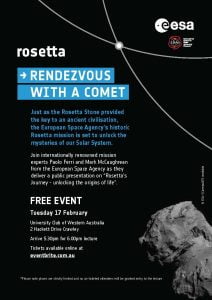After a decade-long journey, ESA’s Rosetta spacecraft has become the first mission to rendezvous with a comet, opening a new chapter in Solar System exploration. Join us as we welcome Dr Paolo Ferri (Head of Mission Operations, pdf biography) and Professor Mark McCaughrean (Senior Science Advisor, pdf biography) from the European Space Agency for a special presentation about this extraordinary mission and the important role played by Western Australia’s own deep space ground station in New Norcia.
- Date: Tuesday, February 17th, 2015
- Location: The University of Western Australia Club
- Time: 5:30pm for a 6pm start.
- Download a printable flyer (pdf, <1MB).
 The Rosetta Mission
The Rosetta Mission
Since its launch in 2004, Rosetta made three flybys of Earth and one of Mars to provide the speed needed to rendezvous with Comet 67P/Churyumov-Gerasimenko, encountering Asteroids 2867 Šteins – a ‘diamond in the sky’ – and the massive 21 Lutetia along the way.
On 6 August 2014, Rosetta made its rendezvous with Comet 67P/C-G, some 405 million kilometres from Earth, about half-way between the orbits of Jupiter and Mars. The comet is on a 6.5-year orbit around the Sun, and both it and Rosetta are now accelerating toward the inner Solar System, and will make closest approach to the Sun in August 2015.
Comets are time capsules, made up of primitive material left over from the birth of the Solar System, 4.6 billion years ago. By studying the gas, dust and structure of the nucleus and organic materials associated with the comet, via both remote and in-situ observations, the Rosetta mission is a crucial key to unlocking the history and evolution of our Solar System as well as answering questions regarding the origin of water, and even the ingredients for life, on Earth.
Since rendezvous, Rosetta’s instruments have been conducting a detailed scientific study of the comet, characterising its nucleus and the environment around it. After a suitable site for the mission’s lander, Philae, was found, it was time for another ambitious first in space history: the first-ever attempt to touch down on a comet’s surface.
On 12 November 2014, Rosetta deployed Philae for a seven-hour descent to Comet 67P/C-G, where it took images and carried out a detailed in-situ analysis. Rosetta’s lander completed its primary science mission after nearly 57 hours on the comet’s surface. Meanwhile, Rosetta is continuing its science mission, accompanying the comet through closest approach to the Sun in August 2015 and beyond, giving us a unique insight into how a comet behaves over time.
The European Space Agency
The European Space Agency (ESA) is Europe’s gateway to space. Its mission is to shape the development of Europe’s space capability and ensure that investment in space continues to deliver benefits to the citizens of Europe and the world.
ESA’s job is to draw up the European space programme and carry it through. ESA’s programmes are designed to find out more about Earth, its immediate space environment, our Solar System and the Universe, as well as to develop satellite-based technologies and services, and to promote European industries. ESA also works closely with space organisations outside Europe, including Australia.

